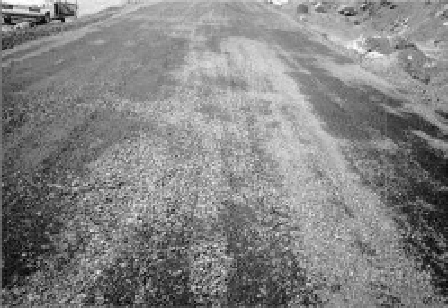Environmental Engineering Reference
In-Depth Information
Table 3.
Basic geotechnical parameters of lapilli.
and, as a result, produces satisfactory 25 MPa
concrete.
Parameter
symbol (Units)
Values
5.2
Lapilli as granular material for highways
aggregates that are used in the canaries for road
construction are obtained from three types of
deposits (enaDiMsa, unpubl.): (a) natural sand
and gravel from alluvial deposits of rivers and
ravines (canary “barranco” deposits); (b) lapilli
from volcanic cones with abundant pyroclasts,
tephra in a general sense (canary “picón” depos-
its); and (c) basalt, phonolite, basanite, and tephrite
lava flows. These are massive formations that yield
aggregates of excellent quality. Their unit weights
are usually high, 27.5-28.5 kn/m
3
, and their use is
very common.
lapilli have been traditionally used in the canary
islands for minor road works (rural paths, forest
tracks, etc.). however, current standards in spain
e.g. FoM/3460/2003 (Ministerio de Fomento, 2003)
require a series of properties for the aggregates used
in highways, and to these requirements there have
to be added those of the european regulations on
aggregate, included in The construction Products
Directive (european economic council, 1989).
lapilli and, in general, pyroclastic deposits
(i.e. tephra) are not suitable materials for the con-
struction of embankments because of their low
density, their high water absorption capacity, and,
consequently, their difficult compaction. however,
when a highway has to cross a zone with thick strata
of lapilli and the embankment of the highway has
to be constructed, then common soil stabilization
methods are frequently used, such as mixing the
soil with cement. lapilli have been also used as a
subbase granular material in flexible pavements
tory results.
Friction angle
غ
34-37
(1)
cohesion
c
(kn/m
2
)
137.3-176.6
(1)
compressive strength
q
u
(Mn/m
2
)
0.39-0.54
(1)
Bearing capacity
q
(kPa)
100-200
(2)
short term slope angle αº
70-85
(2)
long term slope angle
β
º
37-40º
(2)
(1)
Modified from iGMe (1974a)
and
(2)
lomoschitz (1996).
work only loose or weakly welded lapilli have
been considered, although from a geotechnical
perspective, the degree of compaction and
welding among the particles noticeably affect
the quality of these materials, as serrano et al.
(2002) have indicated.
5
laPilli as aGGReGaTe UseD
in consTRUcTion
5.1
Lapilli as aggregate in mass concrete
Guigou Fernández (unpubl.) carried out a
number of tests with mass concrete using differ-
ent ratios among three groups of aggregate: fine
sand, coarse sand, and four types of gravel from
volcanic crushed rock (basalt, phonolite, basaltic
pyroclast, and phonolitic pumice tuff). These grav-
els correspond to three size intervals: 5/10, 10/20,
and 20/40 mm. Using cylinder Test methods with
concrete that contains lapilli as coarse aggregate,
the following results have been obtained:
1. as a result of the low values of the moist unit
weight of lapilli, a very high aggregate/cement
ratio is necessary (0.7 to 0.8 compared with the
habitual rates of 0.55 to 0.65), and only a water
content of between 230 and 260 l/m
3
(23-26 per-
cent in volume) provides a suitable consistency
of concrete;
2. the average values of the dry unit weight,
γ
d
= 17.08 kn/m
3
, and of the saturated unit
weight,
γ
sat
= 19.12 kn/m
3
of the concretes
with lapilli are lower than the standard average
value,
γ
= 22.56 kn/m
3
, used in spain for mass
concrete;
3. the best aggregate ratio, known as type 4D,
includes Portland cement (14 percent); fine
natural sand (11 percent); coarse sand from
crushed rocks (33 percent); and gravels 5/10 (17
percent) and 10/20 (25 percent) (d/D in mm)
made of lapilli;
4. the mean compressive strength (
f
cm
) of con-
crete with lapilli reaches 25.97 MPa at 28 days
Figure 8. Basaltic lapilli used as granular material for a
highway in la Palma island.


















